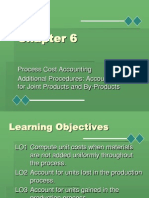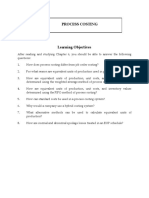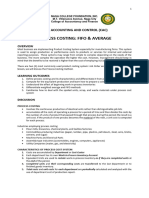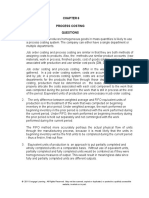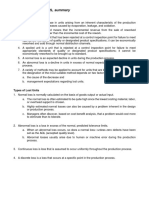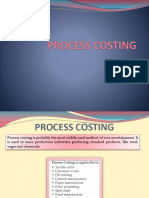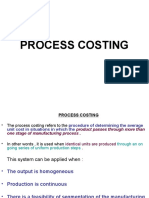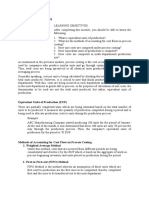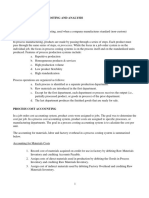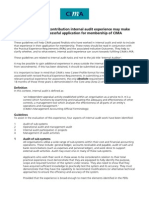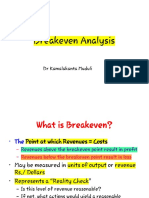PROCESS COSTING
Chapter 8
� PROCESS COSTING
Conversion of Calculation of
Record of Calculation of
Work in Process Per-Unit Costs
Inventory Inventory
Inventory
of Inventory
� PROCESS COSTING
Introduction
n contrast to job order costing, when all units of product manufactured
within a cost center are homogeneous (that is essentially similar),
keeping tract of the cost of separate batches of product is not necessary.
In a process cost system, materials, labor and overhead are charged to
cost centers. The cost assigned to each unit is determined by dividing
the total cost charged to the cost center b the number of units produced.
Cost centers are usually departments but may be processing centers
within departments
�• EQUIVALENT UNITS OF PRODUCTION (EUP) < Determining
the cost of the units transferred out of a department and those
remaining in ending inventory are essentially an allocation process. Since costs
can change over time, a cost flow assumption must be adopted. And since
units of product in ending inventories usually are not fully completed, the
number of equivalent units mast he computed for each cost element (materials,
labor, and overhead). Equivalent unit is the amount of a resource that is
required to complete one unit of product with respect to the cost elements
being considered. Equivalent units of production are an approximation of the
number of whole units of output that could have been produced during a period
from the actual effort expended during that period. These are calculated by
multiplying the number of actual but incomplete units produced by the
respective percentage degree of completion
�The two primary equivalent units of production methods used for process costing are
the following:
This method combines the units in process at the
beginning of the period with the current period production. The total unit to
account for is equal to the total number of whole and partial units worked
during the current period: Beginning
oFIFO Method Under this method, the first units transferred out of the
department are deemed to come from beginning inventory. This method
separates the units in process at the beginning of the period with the current
period production. In order to compute the number of equivalent units of
current period cost required to complete the units in beginning inventory, the
stage of completion of the units in beginning inventory must be known.
�vCOST ANALYSIS In process costing, all cost chargeable to a
department is summarized in a departmental cost of production
report, It shows the total and unit costs of work received from one
or more department; total units of materials, labor, and factory
overhead added by the department, the cost of the beginning and
ending work in process inventories, and the cost transferred to a
succeeding department or to finished goods.
�The following are the two methods of accounting for cost flow in process costing:
ØAverage Method Under this method, the average cost per equivalent unit for
each element of cost is determined by dividing the total cost for each element of cost
(the amount in beginning inventory plus the amount added during the current period)
by the number of equivalent units required to allocate that cost between the units
transferred out of the department and units in ending inventory.
ØFIFO Method Under this method, as the cost of the first units transferred out of
the department are deemed to come from beginning inventory, the units to be
accounted for contains only current period costs. Consequently, equivalent units are
computed for current period costs only. Thus, using this method, the cost per
equivalent unit for each element of cost is determined by dividing the total cost
incurred in the current period by the equivalent units of production.
�vACCOUNTING FOR PRODUCTION LOSSES-PROCESS
COSTING Few, if any, process combine material, labor, and overhead with no
loss of snits Errors in the production process (either by human or machines) cause a
loss of units through rejection at inspection for failure to meet appropriate quality
standards or designated product specifications. Production losses and spoilage may
result from continuous processing of a product. Units are lost through evaporation,
shrinkage, or spoiled works. Lost units reduce the number of units over which total
cost can be spread, and use an increase in unit costs.
qLoss Units Accounting for lost units requires to identify the loss as being,
either normal or abnormal, and specify as being either continuous or discrete. Thus,
a normal loss may either continuous or discrete, and an abnormal loss may either
continuous or discrete.
�qNormal Loss A normal loss of units falls within a tolerance level expected
during the production. The range of tolerance specified by management creates the
Accepted Quality Level (AQL), Normal loss cost is considered a product cost and is
included as part of cost of the good units resulting from the process. Thus, the cost of
the loss is inventoried and expensed only when good units are sold.
qAbnormal Loss Abnormal loss is a los in excess of the normal, predicted
tolerance limits. Thus, when an abnormal loss occurs, so does a normal loss (unless
zero defects have been set as Accepted Quality Level (AQL). The cost of abnormal
losses should be accumulated and treated as a loss in the period in which those
losses occurred.
qContinuous Loss Continuous loss is a loss that is assumed to occur uniformly
throughout the production process. Continuous loss may be normal or abnormal. It is
always accounted for on an equivalent unit basis.
qDiscrete Loss Discrete loss is a loss that occurs at a specific point in the
production process. These units are deemed lost and unacceptable when a quality
check is performed, which is at inspection point. Similar with continuous loos, discrete
loss may be normal or abnormal. It is always accounted for on an equivalent unit
basis.
�THE FOLLOWING TYPES OF PRODUCTION LOSSES WITH CORRESPONDING COST ACCOUNTING
PRINCIPLES ARE DEEMED NECESSARY, IN THE COMPUTATION OF EUP, COST AND ABSORBING
LOST UNITS, WHEN LOSSES WERE DISCOVERED AT THE START, DURING, OR END OF THE PRODUCTION
PROCESS
Ø Normal Continuous
• Not included in the computation of EUP. (The method of neglect simply excludes the
spoiled units in the computation of EUP. However, it is included in the computation of
EUP when discovered at the end of production, because it is already completed when
discovered.)
• Product cost.
• The cost is absorbed by all good units (Work in Process End and transferred out
units).
Ø Normal Discrete
• Included in the computation of EUP based on the degree of completion at inspection
point. (Discrete losses occur specific point, that is, the inspection point.)
• Product cost.
• If the ending inventory has not yet passed an inspection point, the cost of lost units is
�Ø Abnormal Continuous
• Included in the computation of EUP, except when discovered at the
start of the process, where they are removed from the process.
• Period cost.
• Written off as a loss
ØAbnormal Discrete
• Included in the computation of EUP based on the degree of completion
at inspection point, except when discovered at the start of the process,
where they are removed from the process.
• Period cost.
• Written off as a loss
�ALLOCATION OF COST-NORMAL LOSS
The allocation procedure between the Work in Process at the end of the period and
transferred out units depends on the inventory method used: FIFO and Average.
Normal Continuous
Start/ During: Allocated to all good units started and completed, and Work in Process
at the end of the period.
End: Allocated to all units completed and transferred out.
Average
Allocated to all good units completed and Work in Process at the end of the period.
Allocated to all good unita transferred out and Work in Process at the end of the
period.
�Normal Discrete
• If the ending inventory has not yet passed an inspection point, the cost of lost units is
assigned only to the good units transferred out.
• If the ending inventory has passed an inspection point, the cost of the lost units is allocated
to Work in Process at the end of the period and transferred out units, under the following
inventory methods:
• FIFO Average
Based on the current cost contained Based on the total costs contained in each
category before allocation.
in each category before allocation.







